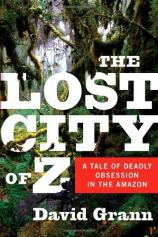The Lost City of Z: A Tale of Deadly Obsession in the Amazon
Review
The Lost City of Z: A Tale of Deadly Obsession in the Amazon
What killed Percy Fawcett and his son Jack as they drove ever deeper into the unexplored regions of the Amazon jungle?
Was it mere malaria, with its sweats and hallucinations? Or simple yellow fever, with its bone-breaking chills and nausea? Was it one of the many species of snake, such as the venomous coral or the crushing 60-foot-long anaconda? Or was it something devious and tormenting like the incessant bites of mosquitoes, flies and ants that could drive a man insane, especially if he had the poor judgment to sleep on the ground? Was it perhaps espundia, lesions that destroy the mucosal surface of the nose, pharynx and larynx, and quickly eat away the face “as if the person were slowly dissolving”? Or was it an arrow from the bow of a hostile Indian, coated with poison so potent that it could blacken a man’s leg and rise to paralyze his heart within hours? Or the treatment by the Indians upon being captured, torture that ranged from being buried alive to the waist and slowly devoured by flies and burrowing maggots that invaded the still living flesh, to being hurled into one of the many twisting fast-rising rivers to be picked apart by the razor sharp teeth of piranhas? Or were they drained of blood, pint by agonizing pint, from the assault of vampire bats?
Whatever fate befell them, one thing is now certain. Percy Fawcett, world famous explorer who bestrode the Victorian world like a colossus, is dead. Author David Grann, a self-described risk-avoider (“given the choice each day between climbing the two flights of stairs to my apartment or riding the elevator, I invariably take the elevator”), found himself caught in “the grip” of Fawcett’s famous exploits, so much so that he felt he must go to the Amazonian jungle himself and try to find some remnant, some evidence, some clue to the last whereabouts of the intrepid adventurer and his athletic, like-minded son. Never mind that hundreds of people since 1925, when Percy and Jack set off, had attempted the same fact-finding mission and many of them likewise never returned.
Grann’s book flies through time, from the early life of Fawcett (a deserting father, a cold, rejecting mother, a stint in the sadistic world of British public schools, followed by further discipline in one of the more draconian military academies); to his inculcation, in Ceylon, into his “destiny” of grand quest for lost cities and undreamed of treasure; to the bizarre fascination Fawcett and Jack nursed for the arcane philosophy of the spiritualist Madame Blavatsky; to the day they set off, convinced they would find the mythical city called Z deep in the Brazilian jungle; to the present, as Grann seeks to uncover through extant sources some clue to the mystery of Fawcett’s walk off the map. Even as Grann tells us about his meeting with Fawcett’s granddaughter and his own preparations for his journey to the jungle, he is taking us back to the multitude of almost unbelievable dangers faced by Fawcett and his son in the dark uncharted forest floor.
That Fawcett could succeed was underscored by the fact that in 1911 American historian Hiram Bingham almost by accident encountered Machu Picchu, certainly one of the planet’s greatest architectural and cultural monuments just sitting there for centuries unviewed by Western eyes. That Fawcett could fail was obvious; many men in his own parties on earlier missions had died horribly, while Fawcett, a gangling heavily mustachioed man of brooding disposition, seemed impervious to fevers and fear. The basic fact was that Fawcett, a man among men, was simply determined to go where no man had gone before, and there were fewer and fewer places where that was possible. His search for the city of Z became a model for such popular sagas as Arthur Conan Doyle’s THE LOST WORLD and the 1991 novel INDIANA JONES AND THE SEVEN VEILS.
One discovery that Grann makes is that civilization --- in the form of well-constructed buildings, fencing and other signs of organization --- can melt away in the jungle labyrinth in only a generation or two. One of the places Fawcett used as an outpost is now nothing but a few bricks lining the forest floor. Grann also realized that some natural phenomena in the Amazonian house of illusions look seductively man-made, such as a stand of stone columns and arches that are the result of centuries of erosion and have fooled many an educated explorer into thinking he had come upon a lost city, a city like Z.
Grann was right. There was no way through it but to do it. He had to go where Fawcett had gone and see for himself. To tell everything he found out would spoil the fun of this highly detailed, exhaustively investigated historical mystery, which truly keeps its reader in “the grip.”
Reviewed by Barbara Bamberger Scott on January 6, 2011
The Lost City of Z: A Tale of Deadly Obsession in the Amazon
- Publication Date: February 24, 2009
- Genres: History, Nonfiction
- Hardcover: 352 pages
- Publisher: Doubleday
- ISBN-10: 0385513534
- ISBN-13: 9780385513531





